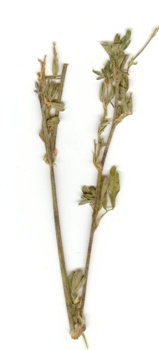Diseases
Erysiphe pisi DC. - Powdery Mildew of Lucerne
Systematic position.
Division Ascomycota, order Erysiphales, family Erysiphaceae, genus Erysiphe.Synonym.
Erysiphe communis auct. p.p.Biological group.
It is a biotroph parasite.Morphology and biology.
Both leaves and stems become covered with white, farinaceous, evanescent to persistent layer of mycelium and conidiophores. Conidiophores are erect; foot-cells sub-cylindrical, sometimes narrowing upward, 15-(20-50)-70 x 6-10 microns. Conidia are single, ellipsoid-cylindrical, 24-55 x 13.5-22 microns. Cleistothecia scattered to gregarious, 80-150 microns in diameter; appendages numerous, located in the lower half of ascocarp, simple, rarely irregularly branched, often interlaced with each other and with mycelium, 4-10 microns wide, 0.25-5 times as long as cleistothecium. Asci are 3-13 in number, shortly stalked, 40-85 x 25-55 microns, 2-6-spored; spores ellipsoid-ovoid, 15-(18-25)-30 x 10-17 microns. The disease appears at the end of June and in the beginning of July. The maximum severity of the disease is observed at the end of summer or in autumn. The fungus winters in form of cleistothecia on plant residues. In spring the ascospores are a source of an initial infection. During the vegetative period the infection is transferred by conidia.Distribution.
This species is found along the Baltic coast, Orel, Samara, Tula, Kursk, Nizhnii Novgorod, Voronezh, Saratov, Omsk Regions, Krasnodar Territory, Ukraine, Armenia, and the North Caucasus. The fungus has not recently been found in Central Asia on cultivated Lucerne, replaced by Leveillula taurica f. medicaginis. It is found on other Lucerne species in Kyrgyzstan (Yssyk-Kol Region) and Tajikistan (the Turkestan ridge).Ecology.
Development of the diseases is favored by dry and hot weather; alternation of the long droughty periods with short-term humid periods (Bilai et al., 1988).Economic significance.
The disease causes the loss of hay and seeds. During favorable years the seed crop may be reduced by 25-30%. Protective actions include: Removal of vegetation residues, observance of the crop rotation recommended for each zone, spatial isolation of seed sites of Lucerne from old crops on not less than 0.5 km, use of resistant cultivars, spraying by fungicides.Reference citations:
Berdysh Yu.I. 2004. Distribution of the main pests and diseases of crops in Krasnodar territory in 2003 and the forecast of their occurrence in 2004. Krasnodar: STAZR. 35 p. (In Russian)Bilai V.I., Gvozdyak R.I., Skripal' I.G., Kraev V.G., Ellanskaya I.A., Zirka T.I., Muras V.A. 1988. Microorganisms - causal agents of plant diseases. Kiev: Naukova Dumka. 552 p. (In Russian)
Borisov S.Yu., Bystrova E.V., Khodkevich L.I., Sidorova V.F., Baranova L.B. 1999. Review of pests and diseases distribution in crops in 1999 and forecast of its occurrence in Saratov Region in 2000 year. Saratov: Region station for plant protection "Saratovskaya". 14 p. (In Russian)
Braun U. 1995. The powdery mildews (Erysiphales) of Europe. Jena, Stuttgart, New York: G. Fischer. 338 p.
Hawksworth D.L., Kirk P.M., Sutton B.C., Pegler D.N. 1995. Ainsworth & Bisby's Dictionary of the fungi. 8th Edition. Kew, Surrey: Commonwealth Mycological Institute. 616 p.
Kalinina I.G., Krivko V.I., Parshikov A.T., Anyutina L.R., Shirokov A.I., Ionin P.F. 1985. Forecast of pests, diseases and weeds distribution in crops in Omsk Region for 1985 and its control. Omsk: Omsk publishing house. 20 p. (In Russian)
Karimov M.A. 1961. Fungal parasites of Lucerne. Tashkent: Ministry of agriculture of Uzbekistan. 208 p. (In Russian)
Luk.yanova L.G., Nikiforova L.S., Komarova L.V., Kulakova M.A., Chechenina M.S., Bakulina G.F., Emel.yanova G.A., Bandulevich N.I., Razumova M.N., Dmitrieva S.N., Gordenko V.I., Mukhina M.Yu., Phephelova N.N. 2001. Forecast of the pests and diseases occurrence and distribution in crops in 2001 year and its control. Nizhnii Novgorod: Nizhegorodskaya regional station for plant protection. 11 p. (In Russian)
Salpagarov N., Smolich I. 1981. Forecast of pests and diseases distribution. Sel.skoe khozyaistvo Kirghizia, 4: 25-27. (In Russian)
Yachevskii A.A. 1927. Pocket handbook on identification of fungi 2. Powdery mildew fungi. Leningrad. 258-259 p. (In Russian)
Zagovora A.V., Beletskii E.N., Budennaya K.I. 1978. Forecast of distribution of pest and diseases of crops in Khar'kov Region in 1978 year and its control. Khar'kov: Khar'kovsk STAZR. 35 p. (In Russian)
© Gasich E.L.


